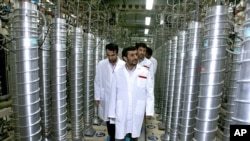GENEVA —
Iran appears to be holding back growth of its most sensitive nuclear stockpile by continuing to convert some of it into reactor fuel, diplomats said on Monday, potentially giving more time for negotiation with world powers.
The stock of medium-enriched uranium gas is closely watched in the West; Israel has threatened to attack if diplomacy fails to curb Iran's program and it amasses enough of the material - a short technical step from weapons-grade - to make a bomb.
The Islamic state says its program is for power generation and medical purposes only, but the election of the relative moderate Hassan Rouhani as president has raised hopes that talks to address the decade-old nuclear dispute could be unblocked.
Since Iran in 2010 began enriching uranium to a 20 percent concentration of the fissile isotope, it has produced more than the 240-250 kg that would be needed for one weapon.
But it has kept the stockpile below the stated Israeli “red line” by converting part of the uranium gas into oxide powder in order, it says, to yield fuel for a medical research reactor.
The diplomats, accredited to the United Nations' International Atomic Energy Agency (IAEA), said Iran might even have stepped up this conversion in recent months.
If this is confirmed in the IAEA's quarterly report, due around Aug. 27-28, the inventory of 20 percent gas will rise by less than the output, which has been about 15 kg per month.
One of the diplomats suggested the stockpile may show little or even no growth during the last three months, saying: “Everyone expects there to be as much or more conversion.”
But he and others cautioned against seeing it as a signal by the new Iranian president as the uranium conversion began in late 2011.
Iran's stockpile of 20 percent uranium gas amounted to 182 kg in May, according to the IAEA's last report, an increase of 9 percent since February but still well below the “red line” set by Israel, believed to be the region's only nuclear weapons power.
While the conversion activity may help to push back any Israeli decision on whether to attack Iranian nuclear sites, Western diplomats say Iran needs to do much more to allay suspicions about its atomic program. They note that uranium oxide powder can be converted back into gas form relatively quickly.
The six powers negotiating with Iran - the United States, France, Germany, Britain, China and Russia - want it to stop enriching uranium to 20 percent and suspend work at the underground Fordow site where most of this activity is pursued.
Rouhani, a former nuclear negotiator who oversaw a previous deal to suspend Iran's uranium enrichment, has pledged to improve ties with the outside world and secure an easing of international sanctions.
But he insists on Iran's right to refine uranium, and the government has made clear that it would expect a major easing of sanctions, which are hurting its oil-dependent economy, in exchange for any agreement to curb enrichment.
The stock of medium-enriched uranium gas is closely watched in the West; Israel has threatened to attack if diplomacy fails to curb Iran's program and it amasses enough of the material - a short technical step from weapons-grade - to make a bomb.
The Islamic state says its program is for power generation and medical purposes only, but the election of the relative moderate Hassan Rouhani as president has raised hopes that talks to address the decade-old nuclear dispute could be unblocked.
Since Iran in 2010 began enriching uranium to a 20 percent concentration of the fissile isotope, it has produced more than the 240-250 kg that would be needed for one weapon.
But it has kept the stockpile below the stated Israeli “red line” by converting part of the uranium gas into oxide powder in order, it says, to yield fuel for a medical research reactor.
The diplomats, accredited to the United Nations' International Atomic Energy Agency (IAEA), said Iran might even have stepped up this conversion in recent months.
If this is confirmed in the IAEA's quarterly report, due around Aug. 27-28, the inventory of 20 percent gas will rise by less than the output, which has been about 15 kg per month.
One of the diplomats suggested the stockpile may show little or even no growth during the last three months, saying: “Everyone expects there to be as much or more conversion.”
But he and others cautioned against seeing it as a signal by the new Iranian president as the uranium conversion began in late 2011.
Iran's stockpile of 20 percent uranium gas amounted to 182 kg in May, according to the IAEA's last report, an increase of 9 percent since February but still well below the “red line” set by Israel, believed to be the region's only nuclear weapons power.
While the conversion activity may help to push back any Israeli decision on whether to attack Iranian nuclear sites, Western diplomats say Iran needs to do much more to allay suspicions about its atomic program. They note that uranium oxide powder can be converted back into gas form relatively quickly.
The six powers negotiating with Iran - the United States, France, Germany, Britain, China and Russia - want it to stop enriching uranium to 20 percent and suspend work at the underground Fordow site where most of this activity is pursued.
Rouhani, a former nuclear negotiator who oversaw a previous deal to suspend Iran's uranium enrichment, has pledged to improve ties with the outside world and secure an easing of international sanctions.
But he insists on Iran's right to refine uranium, and the government has made clear that it would expect a major easing of sanctions, which are hurting its oil-dependent economy, in exchange for any agreement to curb enrichment.









